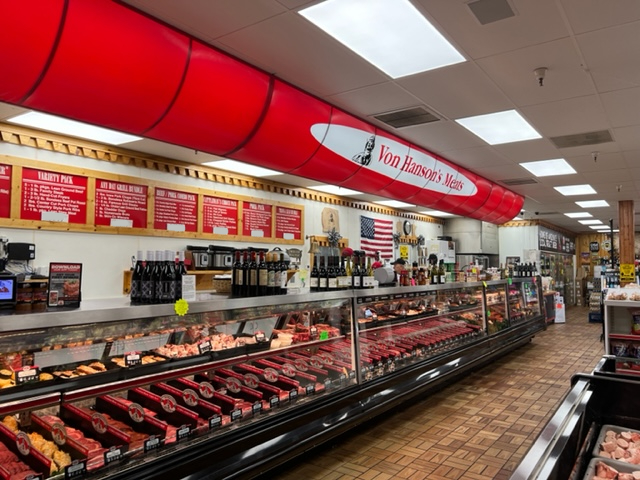Check Out the Regional Flavor at Bagley Farms Meat Market Edwardsville IL: Fresh and Delicious
Check Out the Regional Flavor at Bagley Farms Meat Market Edwardsville IL: Fresh and Delicious
Blog Article
Discover the Art of the Butcher's Cut in a Modern Meat Market
In the ever-evolving landscape of modern-day meat markets, the butcher's cut has transcended its typical roots, combining old-time workmanship with modern techniques. Today's butchers are not simply processors of meat; they are experienced artisans that highlight sustainability and moral sourcing. Their experience in selecting and preparing cuts customized to certain cooking demands provides an unmatched dining experience. Yet, what absolutely sets the contemporary butcher apart is their ability to build a deeper link in between consumers and the origins of their meat. Exactly how do these masters balance custom with technology, and what implications does this have for the future of meat usage?
Development of Butchery Techniques
The development of butchery strategies mirrors a rich tapestry of advancement and adjustment driven by innovations in technology, changes in consumer demand, and a deeper understanding of meat scientific research. Historically, butchery was a craft passed down via generations, with approaches refined over centuries to make best use of return and taste. Nonetheless, the commercial transformation ushered in automation, changing traditional methods and making it possible for large-scale processing.
The mid-20th century saw butchery techniques further fine-tuned by scientific insights into muscular tissue biology and meat aging, improving both tenderness and preference. Innovations like vacuum cleaner packaging and refrigeration expanded product shelf-life, enabling butchers to branch out offerings and improve top quality control. This duration additionally noted the rise of specific devices, such as band saws and meat slicers, which increased precision and performance in meat handling.

The 21st century has actually introduced digital innovation right into the butchery world. Digital systems currently help in monitoring pet provenance and optimizing cuts to satisfy specific customer preferences. In addition, a rebirth in artisanal butchery has actually arised, mixing standard skills with modern expertise to provide to consumers seeking moral and lasting meat options. This evolution underscores a dynamic interplay between practice and innovation, conference contemporary demands while protecting the craft's heritage.
Recognizing Meat Cuts
Comprehending the details of meat cuts is vital for both butchers and customers seeking high quality and worth. For butchers, precise cuts show ability and regard for the craft, ensuring very little waste and optimum return.

Comprehending muscle mass composition is important; muscles made use of a lot more often by the animal often tend to be harder and are best suited for slow-moving food preparation techniques, while less-used muscles, like those located in the loin, are a lot more tender and suitable for grilling or roasting. Knowledge with these differences empowers customers to make educated choices, boosting their cooking endeavors.
Selecting Quality Meat
Picking the best meat entails more than just picking a visually enticing item from the screen. The art of picking quality meat needs a critical eye and expertise of specific characteristics that symbolize quality and quality.
Second of all, consider the marbling, which refers to the white flecks of fat within the muscle mass. Appropriate marbling is a vital indication of tenderness and flavor, as it melts during cooking, improving the meat's juiciness. Keep in mind, greater marbling usually associates with exceptional quality cuts, such as USDA Prime.
Texture is another crucial element; meat must really feel solid to the touch, not slimed or excessively soft. In addition, bear in mind the aroma. Fresh meat needs to have a tidy, neutral scent, without any kind of sour or repulsive smells.
Coupling Cuts With Food Preparation Techniques

Alternatively, harder cuts like brisket and chuck roast are abundant in collagen, which breaks down into look these up jelly when prepared gradually. These cuts are perfect for braising or slow-moving roasting, permitting the meat to tenderize in time and establish deep, intricate tastes. Cuts such as short ribs and pork shoulder get on well with slow-cooking techniques, where prolonged cooking times change their durable structures right into delicious meals.
Lamb shanks and oxtail, which call for long term food preparation to soften, are excellent prospects for cooking or slow-moving simmering. These approaches coax out abundant, passionate flavors while preserving wetness. By comprehending the special attributes of each cut, cooks and home chefs alike can raise their culinary creations, making sure each meal is both satisfying and unforgettable.
The Butcher's Function Today
Navigating the developing landscape of the modern-day meat market, the butcher's role today expands past mere preparation of cuts. Contemporary butchers are culinary craftsmens, educators, and supporters for sustainable methods.
In enhancement see here now to crafting exact cuts, butchers now involve straight with customers, providing cooking guidance and tailoring options to suit specific needs and preferences. Their competence in meat aging, marbling, and flavor profiles empowers consumers to make educated choices, boosting their culinary experiences. This customized service exemplifies the butcher's advancing role as a relied on advisor in the kitchen area.
In addition, butchers are critical in minimizing waste, utilizing entire pets to develop diverse products such as sausages and stocks. This thorough technique not just appreciates the pet but likewise aligns with contemporary sustainability objectives. In this way, the modern butcher personifies both tradition and technology, adapting to an ever-changing market while protecting the virtuosity and stability of their craft.
Final Thought
The modern butcher's craft delicately weaves standard strategies with modern-day developments, emphasizing sustainable practices and ethical sourcing. Mastery in recognizing diverse meat cuts and high quality signs encourages butchers to give enlightened recommendations, aligning particular cuts with optimum cooking methods. This know-how not just raises cooking experiences however likewise strengthens the connection in between consumers and the beginnings of important link their food. By recognizing historical techniques while embracing modern demands, the butcher's role continues to be important in today's innovative meat market (bagley farms meat market edwardsville il).
Report this page